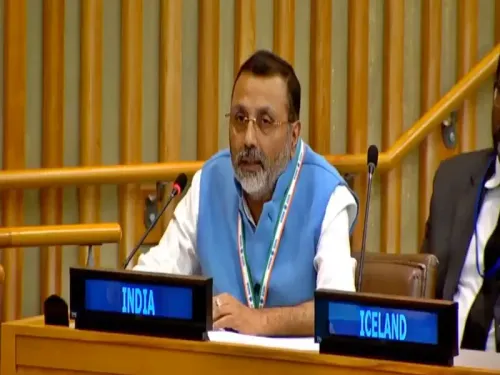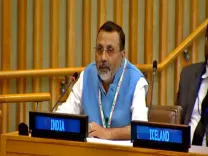How Will GST 2.0 Accelerate Growth Across Goa's Economy?

Synopsis
Key Takeaways
- The GST reforms aim to support Goa's diverse economy.
- Lower tax rates are expected to boost demand for goods and services.
- Tourism plays a crucial role in Goa's economic landscape.
- Pharmaceutical exports are a significant contributor to the economy.
- Fisheries and agriculture sectors will also benefit from reduced costs.
New Delhi, Oct 12 (NationPress) The GST reforms are set to significantly influence Goa’s multifaceted economy, spanning sectors such as tourism, pharmaceuticals, fisheries, construction, and agriculture. The reduction in tax rates is expected to stimulate demand as goods become more affordable and input costs decrease, enhancing competitiveness across various fields.
The decreased GST rates are anticipated to invigorate Goa’s vibrant tourism and hospitality industry, particularly in popular destinations like Calangute, Candolim, Baga, Anjuna in North Goa, and Panaji, along with southern locales such as Colva, Benaulim, and Palolem. By March 2025, this sector employed approximately 250,000 individuals, accounting for nearly 40% of Goa’s total workforce. Furthermore, tourism contributes 16.43% to the state’s Gross State Domestic Product (GSDP), serving as a vital engine for the local economy.
With the reduction in GST rates, input costs are predicted to decline considerably. Common amenities such as toiletries, tableware, and breakfast essentials will become more affordable with the tax dropping from 18% to 5%, likely resulting in a surge in demand.
Restaurants and beverage outlets in Goa—including beach shacks, cafes, and juice stands—will gain from the GST cut from 12% to 5% on fruit juices. This sector, which currently employs about 8,000 individuals, consists of shack vendors, fruit juice sellers, and small kiosk operators who largely depend on tourist traffic.
The ecosystem for autos, taxis, and bike rentals in Goa is set to benefit from the GST decrease on small cars (≤1200cc) and bikes (≤350cc) from 28% to 18%. This change is particularly advantageous for taxi unions and rental businesses operating at airports, railway stations, and coastal areas. This sector supports around 40,000 jobs, including taxi drivers, bike renters, and mechanics, many of whom are self-employed and reliant on tourist demand.
Goa’s pharmaceutical sector, centered in industrial estates such as Verna, Pilerne, Kundaim, Corlim, Bicholim, and Ponda, is backed by logistics from Mormugao port. It employs skilled workers including chemists, lab technicians, and QC staff, with both migrant and local laborers depending on stable employment in formulation and IVD units. The sector serves the Indian diagnostics market and exports to buyers in Asia and Africa, with drugs and pharmaceuticals comprising 51% of Goa’s total merchandise exports in 2023-24.
Thanks to the lower GST rates, many inputs and services have seen reductions from 18% to 5%, while certain medical supplies have been exempted. These changes are set to enhance affordability and competitiveness within Goa’s pharmaceutical landscape.
The construction and real estate industry in Goa has also benefited from the recent GST reforms, which have lowered the tax rate on cement from 28% to 18%, along with reductions on various other materials. These reforms are advantageous for real estate and hotel projects throughout North and South Goa, as well as for infrastructure and homestay developments.
The fisheries and seafood value chain in Goa, crucial to Khariwada (Vasco), Cutbona (Betul), Talpona, Malim, Chapora, and Cortalim, is now enjoying a reduced GST rate of 5% on nets, feed, and aquaculture inputs. This industry contributes around 2.5% to Goa’s GSDP and supports boat crews, small-scale fishers, migrant deckhands, auctioneers, and women vendors, with many coastal households relying on seasonal fishing for their livelihoods.
Items that were previously taxed at 12% and 18% now incur only a 5% tax, leading to an estimated reduction of about 6.25% and 11% in consumer prices, respectively. This directly aids frozen fish and shrimp exporters in Margao and Vasco, enhancing export competitiveness in both local and global markets, including the US, EU, and Japan.
The lower GST rate is also expected to bolster the competitiveness of MSME bakeries, driving higher sales and improving profit margins, particularly for small businesses catering to tourist gifting and exports.
The Goan cashew industry, spanning processing clusters in Sattari, Bicholim, Quepem, and Sanguem, stands to gain from the GST reduction on kernels and value-added products, with rates on certain nuts and confectionery lowered to 5%. This sector employs about 18,500 individuals, including farmers, cashew pickers, nut shellers (mostly women), and processors, with numerous families relying on seasonal wage cycles. It serves both domestic retail and export markets, including the UAE, USA, and EU.
The GST reform decreases costs, enhancing the competitiveness of Goan cashew products. Retail prices for value-added items that previously incurred an 18% tax, now reduced to 5%, such as chocolates and coffee-based preparations, are expected to see a decrease.
Moreover, Goa’s GI-tagged farm products, including Khola Chilli, Harmal (Pernem) Chilli, and the Myndoli (Moira) Banana, will also gain from the tax cuts. This sector encompasses small farmers, spice grinders, and cottage industry processors.









